I've only ever seen examples of armour quilted in geometric patterns in the past, but I guess they could just be repeating patterns.Originally Posted by Watchman
Plutarch, Alexander 32.5:Footnote in Sidnell's Warhorse. Lemme quote it in full. "Alexander himself seems to have swapped his composite linen and metal cuirass, depicted in the Issus Mosaic, for a thickly quilted Persian one captured at Issus. Plutarch, Alexander, translated by Ian Scott-Kilvert (London, 1973), c. 32."
Make what you will out of that, can't say I've read Plutarch myself.
"After sending this message to Parmenio, he put on his helmet, but the rest of his armour he had on as he came from his tent, namely, a vest of Sicilian make girt about him, and over this a breastplate of two-ply linen from the spoils taken at Issus."
So, no, there is no mention of quilting here, just a linothorax. I'm afraid Phil was mistaken with that quote.
I think there are a couple of definitions of quilting, ranging from very specialized to more general in meaning, but what I mean by quilting is this, taken from dictionary.com's definition:1. I don't think that a "quilted armour" has to consist of two sheets and a filling. "Quilting" (if I get it right in English) is a technique to stabilize different layers of material together. So a gambeson padded with some soft stuff which is fixed by stitching can be quilted, as well as a gambeson consisting of different layers of linen stitched together.
5. To stitch together (two pieces of cloth and a soft interlining), usually in an ornamental pattern.
At any rate, let's not let this devolve into a debate over semantics. What I object to here is the recreation of a type of armour in use in the Hellenistic period which has a repeating stitched pattern over the majority of the body.
I don't see why it would be impossible for slingers to wear cuirasses- the tube-and-yoke cuirass was, if we look at iconographic sources, apparently very flexible and the light armour par excellence in the Classical period. It's also obvious from the need that Thucydides felt to mention it that that occurrence was somewhat extraordinary.2. I cannot imagine that the frequently depicted tube-and-yoke armour shall be the spolas. Xenophons mentioning of thorakes and spolades, given to the horsemen and the slingers, must then be interpreted in that way that the spolades were given to the slingers. Of course this is possible. But it would be strange that slingers should wear the same armour so often worn by hoplites. The shoulder flaps could also be a hindrance for a slinger (that could be tested). I think the spolas was a plain leather or linen or leather/linen jerkin, used under the armour or sometimes alone.
Yes, there is a period in the beginning of the T&Y (I'm just going to call it that from now on, instead of tube-and-yoke) that linen armour is also mentioned in literary sources. However, during the T&Y's heyday in Classical and Hellenistic iconographic sources, we hear almost nothing of linen armour, which is exactly the opposite of what one would expect, especially from those writers who were very familiar with their contemporary militaries, such as Thucydides and Polybius.The composite armour spread in use in the 6th c. BC if we can thrust the vase paintings. It has the normal tube-and-yoke form. Alkaios clearly speaks of "thorrakes neo lino". Writing this early in the 6th c. that is a good coincidence and a hint to the linen nature of the tube-and-yoke armour.





 Reply With Quote
Reply With Quote






Bookmarks